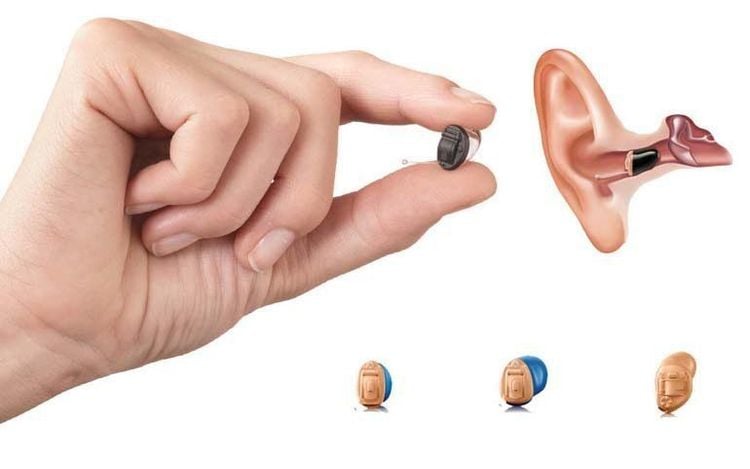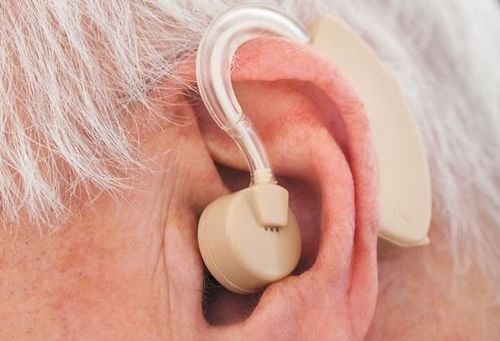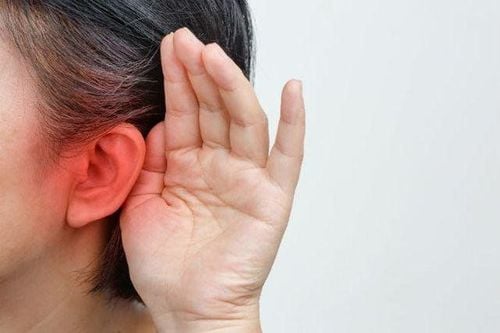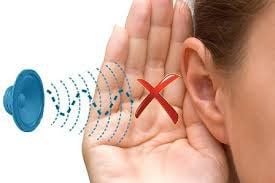This is an automatically translated article.
The article was professionally consulted by Specialist Doctor of Otolaryngology - Department of Medical Examination and Internal Medicine - Vinmec Hai Phong International Hospital.
Hearing aids come in a variety of sizes to cater for different ear sizes and hearing impairments. Therefore, people with hearing loss need to see a doctor for advice on the right type of hearing aid.
1.How do hearing aids help with hearing?
Hearing aids are battery-powered electronic devices that provide hearing aids for people with hearing loss or hearing loss. It's small enough to be worn in or behind the ear, to create louder sound, to help you hear better. Hearing aids support hearing according to the following principles:
Has a microphone that captures sound generated from the surrounding environment Amplifier enhances audible sound The receiver sends amplified sound into the ear. Only 1 in 5 people with hearing loss improve their hearing with hearing aids. Mostly for people with damage to the inner ear or the nerve that connects the ear to the brain due to the following:
Illness Aging Loud sounds Medicines Hearing loss due to problems with the ear canal, eardrum or middle ear is called conductive hearing loss. It can be treated with surgery or other supportive methods. If the outer ear is still functioning well, using a hearing aid can be effective.
People without an external ear cannot use a typical hearing aid. Instead, you can use a bone conduction implant.
SEE ALSO: Methods to improve hearing loss in the elderly

2. How to choose the right hearing aid?
You should have regular check-ups so that your doctor will check to find the cause of your hearing loss. Meanwhile, the audiologist will do tests to classify and assess the severity of the disease. From there, you can be advised to use a hearing aid suitable for your current hearing condition. You should not order hearing aids online as they may not be suitable for your hearing condition.
In case of bilateral hearing loss, you need to wear two hearing aids at the same time to improve hearing.
The first time using a hearing aid, you need to be patient to get used to the device. Take the time to learn how it works and see your doctor to determine the right device, avoiding problems such as:
Discomfort when wearing a hearing aid Voice echo Sound ringing in the ears when connected cell phones You should start wearing your hearing aids in quiet places and keep a diary of how you feel when you use them.
3. Types and models of hearing aids
You need a doctor's consultation to find the right type of hearing aid. Eligibility depends on the following factors:
The type of hearing loss acquired and its severity Age of the person with hearing loss The ability to maintain the device The lifestyle of the deaf person Price of the device There are two types of devices Main hearing aids:
Analog hearing aids: Works on the principle of converting sound waves into electrical signals and then amplifying the sound. This type of machine is usually less expensive and has simple volume controls. Digital hearing aids: Working on the principle of encoding sound waves (sound direction and volume) and then amplifying the sound. This makes it easy to tailor the sound to your needs, which most consoles will do on their own. The price of digital hearing aids is higher than analog hearing aids, but the quality and ability to adjust the sound are better, the size is smaller.

Based on the size, placement and sound amplification method, hearing aids are divided into the following 3 types:
In-the-ear hearing aids: The ITC type has many sizes, suitable for each other ear structure. together. The CIC type is small in size, almost hidden in the ear. Both of these can be used to assist with mild to moderate stress relief. However, this model is not suitable for children and people who find it difficult to use small devices. Type IICs are hidden in the ear and are difficult to see. It can be worn every day or every few months. In-ear (ITE) hearing aids: The ITE is worn to fit completely in the outer ear. This type is good for people with mild to severe hearing loss, but not effective for children, who are still developing ear function and size. Behind-the-ear hearing aids: The BTE type has a plastic box attached behind the ear, the headset attaches to the outer ear and directs sound into the ear. The Mini BTE sits completely behind the ear, with a narrow tube that enters the ear canal. This helps avoid earwax buildup, ensuring your voice is clearly heard. BTE can be used for people with mild to severe hearing loss. The RIC and RITE in-ear loudspeaker hearing aids both have a plastic box behind the ear that connects to an in-ear receiver or ear canal with a small wire. This allows low-frequency sounds to enter the ear naturally and high-frequency sounds to be amplified through the hearing aid. RIC and RITE are good choices for people with mild to severe hearing loss.
4. How to care for hearing aids
You can store your hearing aids in the following ways:
Keep away from heat, moisture, hair care products, children and pets. Clean the hearing aid after use as directed. Turn off the device when not in use. Replace the battery as soon as the battery runs out. Hearing aids can be used for 3 - 6 years. If your hearing condition does not improve with the use of the device, you can change it earlier than expected.
Please dial HOTLINE for more information or register for an appointment HERE. Download MyVinmec app to make appointments faster and to manage your bookings easily.
Reference source: webmd.com










